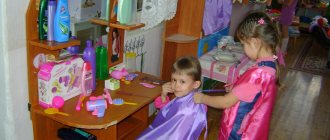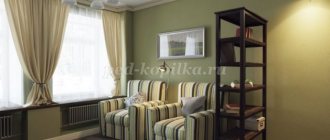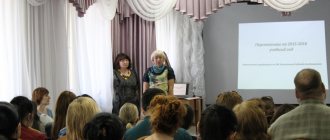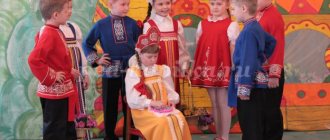It’s safe to say that a new era has arrived – gadgets, new inventions, and scientific discoveries now play a major role in human life. Every day every person receives a huge flow of information. Dealing with him is not so easy. Only those whose brains are highly rigid, who are accustomed to thinking logically and processing not only auditory but also visual information, are capable of this. All these skills must be developed from a very early age. Already in kindergarten, children should receive their foundation. The development of a science center in a preschool educational institution - a mathematical corner is taken as a starting point. It must be constantly updated, attract attention and interest students.
Goals of math corners in kindergartens
A mathematics corner in kindergarten is created with the aim of stimulating the cognitive activity of children and encouraging them to engage in various types of activities in order to acquire new mathematical knowledge and skills in accordance with their age category.
Math corner in a preschool educational institution (preschool educational institution)
The entertaining mathematics corner in kindergarten also performs a number of tasks:
- enrichment and development of the group with materials and equipment that form the mathematical concepts of preschoolers;
- streamlining work on the formation of mathematical concepts in preschool children. The concentration of all the necessary visual and didactic aids in one place simplifies the work of both the teacher and the students who pass by such a corner several times a day. The information located in it is automatically deposited in their minds. The teacher, in turn, evaluates which materials are sufficient and which are not enough, demonstrates them to colleagues, and exchanges experience with them;
- increasing children's interest in mathematics. If the corner is decorated brightly and colorfully, it will attract the attention of even those who have problems with FEMP (formation of elementary mathematical concepts);
- the math corner develops in children interest not only in ordinary games, but also in those that require the manifestation of mental abilities;
- developing the ability to work in a team. Where it is difficult to cope alone, it is easy with friends. For example, when adding a picture from geometric shapes;
- increasing self-esteem and developing self-confidence. Shy children may not always raise their hand in class, even when they know the correct answer. In a mathematical game, they will be able to fully demonstrate their knowledge and receive support from the teacher and other children.
Important! The math corner must correspond to the level of preparation of children and their age characteristics. For example, in the younger group of preschool educational institutions, sensorimotor zones are formed, where children learn the shape of figures, their size, and develop fine motor skills.
Corner “Fun Math” (senior group)
In the older group, the entertaining mathematics corner includes both industrial games and homemade games.
Production games:
- "Figures"
Purpose of the game: introduces basic geometric shapes, teaches you to find objects of the same shape, compare and combine them into groups. Develops attention and perseverance. Conducted with children of junior and senior groups.
- "Arithmetic"
Purpose of the game: introduces numbers and basic arithmetic operations, develops mental counting skills within 10. Teaches how to compose and solve examples. Conducted with children of older, preparatory groups.
- "We believe"
Purpose of the game: introduces the numbers from 1 to 10, strengthens the ability to count and build quantitative chains, and forms elementary mathematical concepts. Conducted with children of older, preparatory groups.
DIY games:
- "Ladybugs"
Purpose of the game: to consolidate the idea of the composition of numbers from two smaller numbers (within 10). Conducted with children of older, preparatory groups.
- Polyanka"
Purpose of the game: to consolidate knowledge about the formation of numbers within 10, to continue to learn how to correlate a number with a number. To consolidate the idea of the composition of numbers from two smaller ones (within 10). Conducted with children of older, preparatory groups.
- "Figured House"
Purpose of the game: to consolidate children's knowledge about geometric shapes, their size and color; secure the account. Distinguish between row and column. Develop attention, memory, logical thinking. Conducted with children of the younger preparatory groups.
- "Fun Mosaic"
Purpose of the game: to consolidate children's knowledge about geometric shapes and primary colors (yellow, red, blue, green). Develop fine motor skills of fingers and children's imagination. Conducted with children of junior and senior groups. Made from salt dough and decorated with gouache.
- Multi-colored rugs"
(from yarn, crocheted)
Purpose of the game: to consolidate knowledge of color, shape, size; develop tactile perception, fine motor skills of fingers, imagination of children; the ability to assemble various structures from geometric shapes. Conducted with children of the younger preparatory groups.
- "Make an object"
(The game is made of viscose napkins).
Purpose of the game: to develop children's thinking, attention, and imagination. Perception of oral and visual information. Improve all types of counting. Learn to generalize and compare objects by size. Develop fine motor skills of the fingers. Form an idea of geometric shapes and shapes. Strengthen the ability to classify objects according to general qualities (shape, size, color). Develop children's speech, the ability to draw simple conclusions. Strengthen and expand spatial understanding.
This game includes many different options:
“Collect beautiful beads” - if desired, children choose different geometric shapes and arrange them in a certain sequence, thereby collecting beads.
“Write the numbers” - the teacher says the number, and the child must lay out the number from any figures that he chooses.
“Write the letter” - the child lays out the letter.
“Lay out an object” - the child lays out, for example, a house (the child himself chooses geometric shapes, then the sun, etc. Subsequently, you can lay out a whole “picture” (develops the child’s creativity).
“Find a pair”, “Find the same...” - learn to select geometric shapes different in size, shape, color, compare and find similarities and differences. Develop observation skills.
"What changed? » practice correctly naming geometric shapes and develop visual memory.
“Pick a figure” - consolidate children’s ideas about geometric shapes and practice naming them.
“Three squares” - teach children to correlate three objects by size and indicate their relationships with the words: “big”, small”, “medium”,
biggest", "smallest".
“Geometric Lotto” - teach children to compare the shape of the depicted object with a geometric figure and select objects according to a geometric pattern.
“What kinds of shapes are there?” - introduce children to new shapes: oval, rectangle, triangle, pairing them with already familiar ones: square-triangle, square-rectangle, circle-oval.
“Who has what shape” - teach children to group geometric shapes (ovals, circles) by shape, distracting from color and size.
- Albums and cards with various tasks for the development of logical thinking in children:
- “Which item is extra and why?”
- “What do these objects have in common?”
- “How are the pictures different?”
- "Find the similarities"
- "Turn on your attention"
- "Confusion"
- "Trainer for the mind"
(made of plastic caps).
Purpose of the game: to consolidate primary colors, develop fine motor skills of the fingers, consolidate ordinal and quantitative counting.
Requirements for organizing a corner according to Federal State Educational Standards
In order for the mathematics corner to fully comply with federal state educational standards, you need to remember a number of factors at once.
Safety and protection of child's life:
- The material equipment of the corner should not contain any items potentially hazardous to life and health (pea seeds, beans, buttons, beads, etc.). If bags, for example, with beans, are needed for the development of fine motor skills, then they must be tightly tied or sewn up, and work with them must be carried out strictly under the supervision of a teacher;
- Do not use geometric shapes made of hard plastic. The child may be injured by their corners. You should choose either soft plastic or cardboard;
- The places where toys are stored should be at the child's eye level so that he does not need to reach for them or stand on a chair. All shelves must be firmly attached to the wall;
- The corner should be in a well-lit place. There should be tables and chairs nearby where mathematical games will be played. They must match the height of the children.
How to learn colors in English with children - useful exercises
Accessibility and age-appropriateness of the group. All materials must be selected based on this criterion. You can take an additional three or four games for advanced development from tasks for older ages.
One of the criteria for designing a math corner according to the Federal State Educational Standard is the diversity of its content. The games contained in it must cover all those areas that are considered within the framework of the FEMP program.
The connection between mental, practical and experimental activities:
- in accordance with the standard, children should not only be able to see the number in the picture and correlate the number of drawn objects with it, but also, with the help of natural material, independently add this number, decompose it into parts, and perform other actions that interest them;
- It is important to have a wide selection of geometric materials so that children gain a complete understanding of the shape and properties of shapes.
In the mathematics corner, all conditions must be created for creative self-expression and development of children. There should be materials for modeling, geometric coloring books, even counting sticks, which children love so much. Everything is limited only by the teacher’s imagination.
Important! From the first day, it is necessary to teach children to clean up after themselves, put everything neatly on shelves, and put it in its place. This will help avoid clutter in the corner and teach “little mathematicians” discipline and responsibility.
Design of a math corner
As has already been said, each age period requires its own mathematical corner, with its own tasks that will be of interest to children of this particular group. This is the most important rule. With the children of the senior and preparatory groups, you can jointly select the contents of the corner and come up with a name for it.
In the younger group
Items to fill the corner in the younger group:
- construction sets (wooden or plastic) with various geometric shapes. When working together with a teacher, children learn how to correctly name objects, study their properties and size. Also, when comparing two identical figures made of different materials, kids conclude that weight does not depend on the shape;
- mosaics and puzzles. They must be large in size so that the child does not swallow their parts. Thanks to these objects, children learn to identify sides: up, down, right, left, and also develop creative thinking;
- pyramids with rings of different sizes and shapes. Kids compare rings by size, try to put them on in the correct order, and rejoice at the positive result;
- nesting dolls. Fold them according to size, line them up, try to fold them evenly;
- printed corner filling. For example, a poster with the seasons;
- modern educational games.
Important! When decorating a corner, as a rule, it is decorated with characters from fairy tales and cartoons. For pupils of the younger group, many of the heroes may still be unfamiliar, so it is worth paying attention to simple and favorite heroes: a bunny, a fox, a cat, a bun.
Math corner in the younger group
In the middle group
The math corner in the middle group of the kindergarten is supplemented with a large number of new subjects. The thinking of children of this age category becomes more abstract, and therefore these subjects should be aimed at its active development.
- Printed games. Can be purchased in a store or made independently (the latter should be wrapped in cellophane or laminated);
- Since children during this period want to study not only objects, but also smells and tactile sensations, you can put tightly closed bottles in a corner containing pieces of fabric soaked in various essential oils (none of the children should be allergic to these smells );
- children's musical instruments, for example, xylophone, metallophone, triangle. With their help, you can not only develop children's hearing, but also teach counting (by the number of strokes with a stick or keystrokes);
- mathematical material is supplemented by games with numbers, numbers, and counting;
- notebooks with a printed base for independently completing mathematical tasks;
- games like “Tangram”, “Lego” constructor, etc.
Lessons of traditional and non-traditional drawing in kindergarten
Important! In the middle group, children quickly lose interest in the same games; they no longer want to do what they have learned. Therefore, the filling of the corner should be updated at least once every two months, leaving only the most favorite and interesting toys.
Math corner in the middle group
In the older group
A feature of children of senior preschool age is the development of abstract verbal thinking. During this period, they become more organized and disciplined, they want to achieve success and prove themselves not only in classes, but also in independent activities.
The content of the mathematical corner is replenished and expanded. It includes games for ingenuity and ingenuity such as “Find the odd one out”, “Where is the artist’s mistake?”, “It happens - it doesn’t happen”, etc. Games for comparing a number of objects according to several criteria at once will also be interesting. For example, if children in the middle group could line up a series of animals based on their height, then here they can line up a series of animals from the forest, Africa, etc. based on their height.
Developmental literature appears in the mathematical corner. Children are very interested in finding answers to questions on their own, as well as learning something new. Various encyclopedias will help them with this; books with bright pictures will be especially interesting. It is worth explaining to children that no additional inscriptions can be made in books.
Note! Puzzles will also be interesting - both in printed notebooks and subject ones.
You can offer materials for the game “School”; children at that age really like it, like other role-playing games.
Math corner in the senior group
Organization of an entertaining mathematics center in a group
- September 3, 2017
International and All-Russian competitions
All-Russian competition “Portfolio of a teacher of a preschool educational institution”
Mathematics plays a huge role in mental education and in the development of intelligence. Its study contributes to the development of memory, speech, imagination, emotions; forms perseverance, patience, and creative potential of the individual.
The main goal of doing mathematics is to give the child a sense of self-confidence, based on the fact that the world is orderly and therefore understandable, and therefore predictable for humans. Mathematics has a unique developmental effect. “Mathematics is the queen of all sciences! She puts her mind in order!
Having studied the literature on pedagogy, I came to the conclusion that the maximum effect with FEMP can be achieved using didactic games, entertaining exercises, tasks and entertainment. Therefore, for an in-depth study, I chose the topic: “FEMP through educational games.”
Working on this topic, I set myself a goal: to organize work on FEMP for preschool children in accordance with modern requirements using educational games to develop memory, attention, imagination, and logical thinking.
In accordance with the Federal State Educational Standard, my task is to develop creative cognitive activity in children. A condition for the successful implementation of this task is the organization of a subject-development environment in the senior group. The developmental environment, in accordance with the Federal State Educational Standard, must be content-rich, transformable, variable, accessible and, of course, safe.
I try to organize the developmental environment in our group in such a way as to provide the opportunity to most effectively develop the individuality of each child, taking into account his inclinations, interests, and level of activity.
For the child’s mathematical activity, I created conditions under which he would show independence in choosing gaming material, games, based on his developing needs and interests. During the game, which arises on the initiative of the child himself, he becomes involved in complex intellectual work.
I consider the teacher’s selection of games, toys, and play equipment to be an important condition in organizing a developmental environment. The saturation of the subject-developmental environment should be reasonable. Games should be appropriate to the age of the children and the tasks that are being solved at this stage. Shelves should not be cluttered with excess material.
The teacher needs to promptly change the subject-game environment through new attributes, games, toys, and gaming equipment in accordance with the new content of the games. Of course, the accessibility of the content of the subject-development environment for children is also important: games, toys, and various gaming attributes should be located no higher than the child’s outstretched arm.
Goal: organizing work on FEMP for preschool children in accordance with modern requirements using educational games.
When creating a math corner for older children, I solved the following problems :
- Purposefully develop children's interest in elementary mathematical activities.
- To develop the qualities and personality traits of the child necessary for successful mastery of mathematics in the future: purposefulness and expediency of search actions, the desire to achieve a positive result, perseverance and resourcefulness, independence.
- To instill in children the need to occupy their free time not only with entertaining games, but also with games that require mental stress and intellectual effort. Entertaining mathematical material in preschool and subsequent years should become a means of organizing useful leisure time and promoting the development of creativity.
The success of play activities in a corner organized in a group is determined by the interest of the teacher himself in entertaining tasks for children. The teacher must have knowledge about the nature, purpose, developmental impact of entertaining material, and techniques for guiding independent activity with elementary mathematical material. The interest and passion of the teacher is the basis for children to show interest in mathematical problems and games.
When creating a mathematical corner, I tried to clearly reflect those areas of FEMP (familiarity with size, quantity, orientation in space, time, shape) through the use of thematic dolls. Didactic games were also selected according to the directions .
For example, for quantity : n/game “Learning about counting”, d/i “Counting with Mowgli”, “Arithmetic”, “Counting little niggas”, “My first numbers”, “Entertaining numbers”, “Funny numbers”, “Math cubes” ", "Find a neighbor", "Mathematics", "Let's play and count", "Mathematical lotto", "Loto numbers", "Feed the fish", "Number houses", pictures "Make up a problem", dominoes.
By size : “Balls”, “Christmas trees”, “Sticks in a row”, “Who will roll the ribbon faster”, “Fold the boards”, pictures “Size of objects”.
On the form : “Geometric shapes”, “Color and shape”, Lotto “Colors and shapes”, “Tricky objects”, “Finish the row”, “Collect the figures”, “The fourth odd one”, “Fun logic”, “Logical dominoes” , dominoes “Learning shapes and colors”, wonderful bag.
For time : “Parts of the day”, “Time”, “First hours”, Seasons”, models “Parts of the day” and “Days of the week”.
For orientation in space : “Tell me about your pattern”, “Find a paired picture”, “Sun”, “Preschooler’s folders: “Orientation in space”, “Labyrinth”, “Orientation by cells”.
The creation of a corner is preceded by the selection of gaming material, which is determined by the age capabilities and level of development of the children in the group. A variety of entertaining material is placed in the corner so that each child can choose a game for themselves.
These are board and printed games, games for the development of logical thinking, leading children to master checkers and chess, puzzles; logic problems and cubes, labyrinths; games for composing a whole from parts, for recreating silhouette figures from special sets of figures; movement games. They are all interesting and entertaining.
When organizing an entertaining mathematics corner, I proceed from the principles of games being accessible to children at the moment, and place in the corner such games and gaming materials that children can master at different levels.
From mastering the given rules and game actions, they move on to inventing new game options. There are great opportunities for creativity in the “Cubes for Everyone” games: “Unicube”, “Nikitin’s Cubes”, Montessori inserts, Nikitin’s Square, Nikitin’s dots, Geometric tablet, Cuisenaire sticks, Dienesh blocks.
The essence of these games is to recreate on a plane the silhouettes of objects, animals, birds, people in an image or design. Children can come up with new, more complex silhouettes not only from one, but also from 2 - 3 sets for the game; one and the same silhouette, for example, a fox, can be composed of different sets. For a long time, these puzzles were used to entertain adults and teenagers, but modern research has proven that they are an effective means of mental, particularly mathematical, development of preschoolers.
Counting sticks have traditionally been used as a counting material. However, their diverse design capabilities make it possible to form geometric concepts in children and develop spatial imagination. Games with counting sticks create great opportunities for developing not only ingenuity and ingenuity, but also through the discovery of new ways of acting with material, activity and independence.
Our group has created, which includes:
- sets of counting materials and a fan of numbers for each child,
- sets of three-dimensional geometric shapes of different sizes (large wooden construction set "Polikarpova", small colored wooden construction set,
- entertaining and educational didactic games,
- multifunctional educational aids “Clock”, “Locomotive from Romashkovo”, panel “Travel through Time”, mathematical tablet “Geometric”,
- watches: with dial and hourglass,
- various toys with laces and “Turtle” fasteners,
- colored paper clips.
In the group, children play “Shop” using coins to consolidate knowledge about coins with denominations of 1, 5, 10 kopecks, 1, 2, 5, 10 rubles (discrimination, selection and exchange of coins); to the “Barbershop”, in which girls measure ribbons by length (to strengthen the ability to measure the width and height of objects, that is, straight line segments); in “Kitchen” to strengthen children’s ability to measure the volume of liquid and granular substances using a conventional measure).
Thus, our subject-development environment in the group helps to consolidate children’s knowledge, enrich their social experience, and develop children’s creativity. It gives us teachers the opportunity to implement a person-centered approach, and also helps to unlock the creative potential of the teacher and children.
Selection of interesting material
Interesting mathematical material is not so easy to find, but with basic guidelines, you can cope with any task. This is especially true for young teachers who come to work in kindergarten for the first time. In order to avoid mistakes, they should seek help from older, experienced colleagues, study the design of their mathematical corners, and on what basis they should perform their own. First of all, it is necessary to take into account the age of the pupils and the characteristics of this period in the children’s lives. By combining this knowledge, the teacher will be able to choose the right methodology and develop his own unique mathematical corner.
Love math
In a preschool educational institution, it is very important for the teacher to do everything possible to instill in children an interest in mathematics. Then they will not have problems with this science in the future. In addition, well-prepared children, with developed abstract-logical thinking, will be more successful in school, not only in mathematics lessons, but also in other classes. Mathematics develops the ability to think, and this is the main skill that is useful in all areas.








